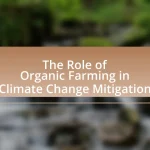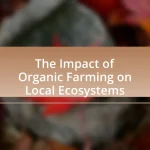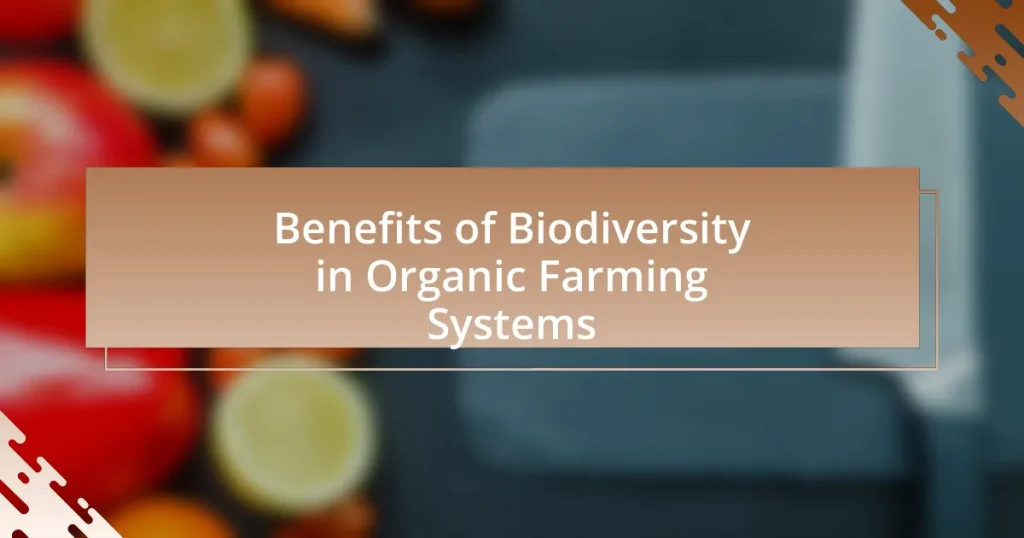Biodiversity in organic farming systems plays a crucial role in enhancing ecosystem resilience, improving soil health, and increasing crop yields. The article outlines how diverse plant and animal species contribute to natural pest control, enhance nutrient cycling, and support pollinator populations, all of which are vital for agricultural productivity. It discusses specific benefits such as improved soil structure, enhanced pest management through natural predators, and increased genetic diversity among crops, which collectively lead to greater yield stability and economic advantages. Additionally, the article highlights effective practices for promoting biodiversity, including crop rotation, intercropping, and the use of cover crops, emphasizing their importance in sustainable organic farming.
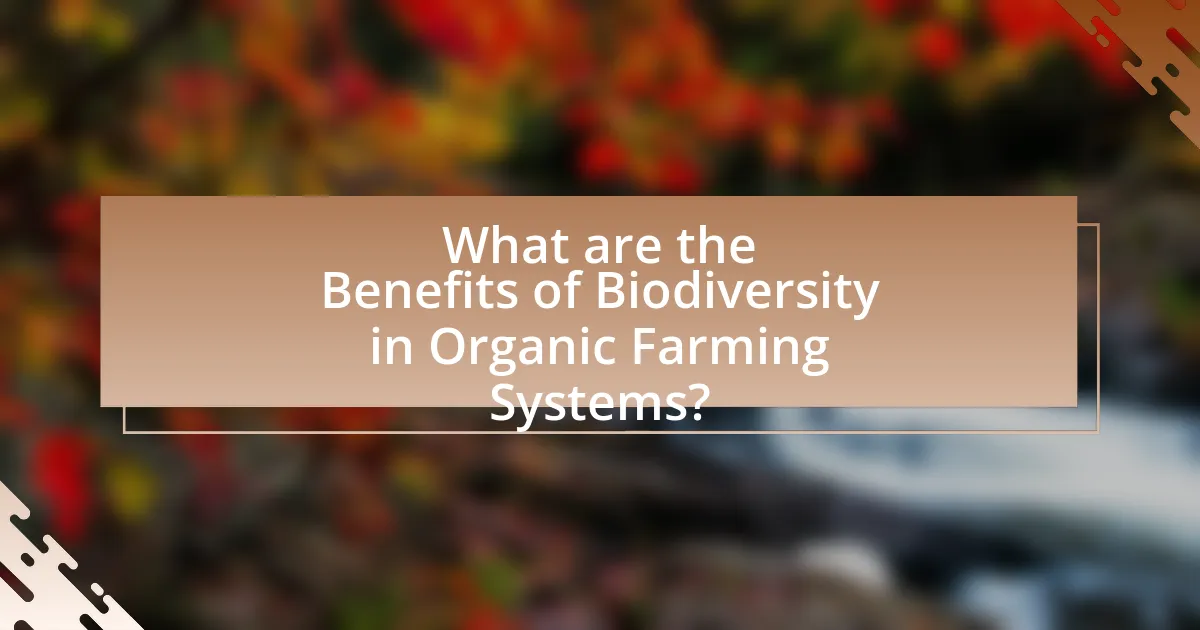
What are the Benefits of Biodiversity in Organic Farming Systems?
Biodiversity in organic farming systems enhances ecosystem resilience, improves soil health, and increases crop yields. Diverse plant and animal species contribute to natural pest control, reducing the need for chemical pesticides, which is supported by studies showing that farms with higher biodiversity experience fewer pest outbreaks. Additionally, a variety of crops can improve soil structure and nutrient cycling, leading to healthier soils, as evidenced by research indicating that polycultures can yield up to 20% more than monocultures. Furthermore, biodiversity supports pollinator populations, which are crucial for the reproduction of many crops, thereby directly impacting agricultural productivity.
How does biodiversity contribute to soil health in organic farming?
Biodiversity significantly enhances soil health in organic farming by promoting a diverse ecosystem of microorganisms, plants, and animals that contribute to nutrient cycling and soil structure. Diverse microbial communities improve soil fertility by breaking down organic matter and facilitating nutrient availability, while varied plant species contribute to root diversity, which enhances soil aeration and water retention. Research indicates that farms with higher biodiversity levels often exhibit improved soil organic matter content and microbial activity, leading to healthier soils. For instance, a study published in “Nature” by Cardinale et al. (2012) found that biodiversity loss negatively impacts ecosystem functioning, including soil health, underscoring the critical role of biodiversity in maintaining robust organic farming systems.
What specific soil organisms are enhanced by biodiversity?
Biodiversity enhances specific soil organisms such as mycorrhizal fungi, nitrogen-fixing bacteria, and earthworms. Mycorrhizal fungi form symbiotic relationships with plant roots, improving nutrient uptake and soil structure. Nitrogen-fixing bacteria, like Rhizobium, convert atmospheric nitrogen into a form usable by plants, enriching soil fertility. Earthworms aerate the soil and contribute to organic matter decomposition, promoting nutrient cycling. Studies have shown that diverse plant communities support a wider range of these beneficial organisms, leading to improved soil health and productivity in organic farming systems.
How does soil biodiversity affect nutrient cycling?
Soil biodiversity significantly enhances nutrient cycling by promoting a diverse array of microorganisms and macroorganisms that facilitate the decomposition of organic matter and the transformation of nutrients. This diversity ensures that various soil organisms, such as bacteria, fungi, and earthworms, work synergistically to break down complex organic materials, releasing essential nutrients like nitrogen, phosphorus, and potassium into forms that plants can readily absorb. Research indicates that soils with higher biodiversity exhibit increased rates of nutrient mineralization and improved soil structure, which further supports plant growth and resilience. For instance, a study published in “Nature” by van der Heijden et al. (2008) demonstrated that diverse microbial communities can enhance nutrient availability and uptake in plants, thereby underscoring the critical role of soil biodiversity in nutrient cycling processes.
Why is pest control improved through biodiversity in organic farming?
Pest control is improved through biodiversity in organic farming because diverse ecosystems enhance natural pest regulation. In organic farming, a variety of plants and animals create habitats for beneficial organisms, such as predators and parasitoids, which help control pest populations. Research indicates that farms with higher biodiversity experience lower pest incidence, as these beneficial species can effectively manage pest outbreaks. For example, a study published in the journal “Agriculture, Ecosystems & Environment” found that increasing plant diversity on farms led to a significant reduction in pest damage, demonstrating the effectiveness of biodiversity in enhancing pest control mechanisms.
What role do natural predators play in pest management?
Natural predators play a crucial role in pest management by naturally controlling pest populations, thereby reducing the need for chemical pesticides. These predators, such as ladybugs, lacewings, and predatory mites, feed on various pest species, including aphids and spider mites, which helps maintain ecological balance. Research indicates that the presence of natural predators can lead to a significant decrease in pest numbers; for instance, studies have shown that fields with higher biodiversity, including natural predators, can experience up to 50% less pest damage compared to monoculture systems. This natural pest control not only supports sustainable farming practices but also enhances crop yields and promotes overall ecosystem health.
How does plant diversity reduce pest outbreaks?
Plant diversity reduces pest outbreaks by enhancing ecosystem resilience and promoting natural pest control mechanisms. A diverse array of plants can attract a variety of beneficial insects, such as predators and parasitoids, which help manage pest populations. Research indicates that polycultures, or systems with multiple plant species, can reduce pest incidence by up to 50% compared to monocultures. This reduction occurs because diverse plantings disrupt pest life cycles and provide habitats for natural enemies, thereby decreasing the likelihood of pest outbreaks.
In what ways does biodiversity enhance crop resilience?
Biodiversity enhances crop resilience by increasing genetic variation, promoting ecosystem stability, and improving pest and disease resistance. Genetic diversity within crop species allows for a wider range of traits that can withstand environmental stresses, such as drought or disease. For instance, diverse plant varieties can share beneficial traits, leading to improved overall health and productivity. Additionally, a diverse ecosystem supports natural predators and beneficial organisms that help control pests, reducing the need for chemical interventions. Research indicates that farms with higher biodiversity can yield more stable outputs over time, as they are better equipped to adapt to changing conditions and resist shocks, such as climate variability or pest outbreaks.
How do diverse plant species contribute to climate adaptability?
Diverse plant species enhance climate adaptability by increasing ecosystem resilience and promoting functional diversity. This variety allows ecosystems to better withstand and recover from climate-related stresses, such as droughts and floods. For instance, studies show that polycultures, which include multiple plant species, can outperform monocultures in terms of yield stability under variable climatic conditions. Research published in “Nature” by Isbell et al. (2011) indicates that biodiversity can improve ecosystem productivity and stability, demonstrating that diverse plant communities are more effective at utilizing resources and adapting to changing environments.
What are the benefits of genetic diversity among crops?
Genetic diversity among crops enhances resilience to pests, diseases, and environmental changes. This diversity allows for a wider range of traits that can improve crop yield and quality, as different varieties may possess unique adaptations to specific conditions. For instance, studies have shown that diverse crop systems can reduce the risk of total crop failure, as some varieties may thrive under adverse conditions while others may not. Additionally, genetic diversity contributes to soil health and ecosystem stability, which are crucial for sustainable agricultural practices. Research indicates that farms with higher genetic diversity can better withstand climate variability, leading to more consistent food production over time.
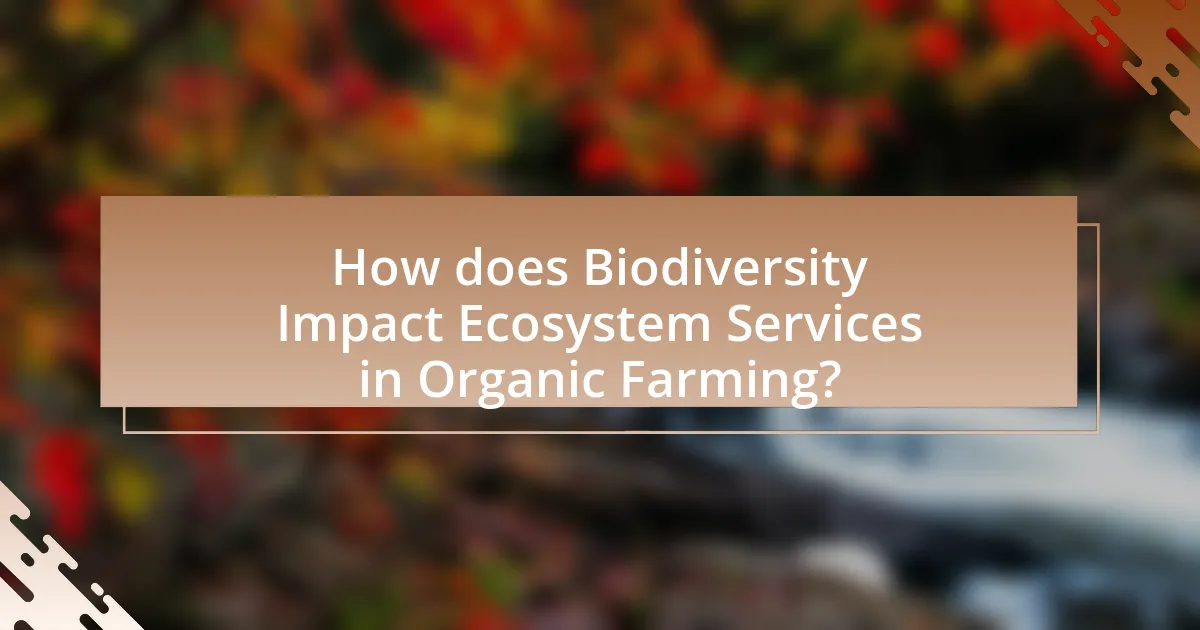
How does Biodiversity Impact Ecosystem Services in Organic Farming?
Biodiversity significantly enhances ecosystem services in organic farming by promoting soil health, pest control, and pollination. Diverse plant and animal species contribute to nutrient cycling and improve soil structure, which leads to increased fertility and resilience against diseases. For instance, studies have shown that farms with higher plant diversity can reduce pest populations naturally, minimizing the need for chemical interventions. Additionally, a variety of flowering plants supports a broader range of pollinators, which is crucial for the production of many crops. Research indicates that organic farms with greater biodiversity can yield more stable and sustainable outputs, demonstrating the critical role of biodiversity in maintaining ecosystem services essential for organic farming success.
What ecosystem services are provided by diverse farming systems?
Diverse farming systems provide essential ecosystem services such as enhanced soil fertility, improved pest control, increased pollination, and greater resilience to climate change. These services arise from the variety of crops and livestock, which promote biodiversity and ecological balance. For instance, studies show that polycultures can lead to a 20-60% increase in crop yields compared to monocultures due to improved nutrient cycling and reduced pest outbreaks. Additionally, diverse farming systems support a wider range of beneficial insects, which are crucial for pollination, thereby boosting overall agricultural productivity.
How does biodiversity support pollination services?
Biodiversity supports pollination services by providing a variety of plant species that attract different pollinators, enhancing the overall effectiveness of pollination. Diverse ecosystems, including various flowering plants, create habitats for a wide range of pollinators such as bees, butterflies, and birds, which are essential for the reproduction of many crops. Research indicates that farms with higher plant diversity can increase pollinator abundance and diversity, leading to improved crop yields. For instance, a study published in the journal “Ecological Applications” found that increased floral diversity on farms significantly boosted pollination rates and crop production, demonstrating the critical role of biodiversity in sustaining pollination services.
What is the relationship between biodiversity and water management?
Biodiversity and water management are closely interconnected, as diverse ecosystems enhance water quality and availability. Healthy biodiversity contributes to the regulation of water cycles, improves soil structure, and promotes the filtration of pollutants, which is essential for sustainable water management. For instance, wetlands, which are rich in biodiversity, act as natural water filters, removing contaminants and providing flood control. Studies have shown that areas with higher biodiversity can retain more water and reduce erosion, thereby supporting agricultural productivity and resilience in organic farming systems.
How does biodiversity influence the overall productivity of organic farms?
Biodiversity significantly enhances the overall productivity of organic farms by promoting ecosystem resilience and improving soil health. Diverse plant and animal species contribute to a more stable environment, which can lead to increased crop yields. For instance, studies have shown that farms with higher biodiversity can produce up to 20% more food per unit area compared to monoculture systems. This increase in productivity is attributed to various factors, including improved pollination, natural pest control, and enhanced nutrient cycling, all of which are facilitated by a diverse range of organisms working together in the ecosystem.
What are the economic benefits of increased biodiversity in farming?
Increased biodiversity in farming leads to enhanced economic benefits such as improved crop yields, reduced input costs, and increased resilience to pests and diseases. Diverse farming systems can produce higher yields due to complementary interactions among different species, which can enhance soil health and nutrient cycling. For instance, a study published in the journal “Nature” found that farms with greater plant diversity had yields that were up to 20% higher compared to monoculture systems. Additionally, increased biodiversity can lower the need for chemical fertilizers and pesticides, resulting in cost savings for farmers. Furthermore, diverse ecosystems can better withstand environmental stresses, reducing the risk of crop failure and ensuring more stable income for farmers.
How does biodiversity affect yield stability over time?
Biodiversity enhances yield stability over time by promoting ecosystem resilience and reducing vulnerability to pests and diseases. Diverse crop and plant species can better withstand environmental fluctuations, such as droughts or floods, compared to monocultures. Research indicates that systems with higher biodiversity can yield 20-30% more stable outputs over time, as diverse species interactions lead to improved nutrient cycling and pest control. For instance, a study published in “Nature” by Isbell et al. (2011) demonstrated that biodiversity loss negatively impacts ecosystem productivity and stability, reinforcing the importance of maintaining diverse agricultural systems for consistent yields.

What Practices Can Enhance Biodiversity in Organic Farming Systems?
Practices that can enhance biodiversity in organic farming systems include crop rotation, intercropping, cover cropping, and the use of organic amendments. Crop rotation promotes soil health and disrupts pest cycles, leading to a more diverse ecosystem. Intercropping, or growing multiple crops in proximity, increases habitat diversity and can improve pest control. Cover cropping helps prevent soil erosion and enhances soil fertility, which supports a wider range of organisms. The application of organic amendments, such as compost, enriches the soil microbiome, fostering a diverse array of soil life. These practices collectively contribute to a resilient agricultural system that supports various species and ecological functions.
What are the best practices for promoting biodiversity on organic farms?
The best practices for promoting biodiversity on organic farms include implementing crop rotation, intercropping, maintaining hedgerows, and utilizing cover crops. Crop rotation enhances soil health and disrupts pest cycles, while intercropping increases habitat diversity and reduces disease spread. Maintaining hedgerows provides shelter and food for beneficial organisms, and cover crops improve soil structure and fertility. Research indicates that farms employing these practices can increase species richness and abundance, leading to more resilient ecosystems. For instance, a study published in “Agriculture, Ecosystems & Environment” by Tscharntke et al. (2012) found that diverse farming systems support higher levels of biodiversity compared to monocultures.
How can crop rotation improve biodiversity?
Crop rotation can improve biodiversity by promoting a diverse range of plant species and enhancing soil health. This agricultural practice reduces the dominance of any single crop, which can lead to increased habitat availability for various organisms, including beneficial insects and soil microbes. Research indicates that diverse cropping systems can support higher levels of biodiversity compared to monocultures, as they provide varied food sources and habitats. For instance, a study published in “Agriculture, Ecosystems & Environment” by Altieri and Nicholls found that crop rotation increased the abundance of beneficial arthropods, which are crucial for pest control and pollination. Thus, implementing crop rotation not only fosters a more resilient ecosystem but also contributes to sustainable agricultural practices.
What role do cover crops play in enhancing biodiversity?
Cover crops play a crucial role in enhancing biodiversity by providing habitat and food sources for various organisms, including beneficial insects, soil microbes, and wildlife. These crops improve soil health and structure, which supports a diverse range of plant and animal life. Research indicates that cover crops can increase the abundance and diversity of soil microorganisms, which are essential for nutrient cycling and ecosystem resilience. For instance, a study published in the journal “Agriculture, Ecosystems & Environment” found that fields with cover crops had significantly higher levels of microbial diversity compared to those without, demonstrating their effectiveness in promoting a biodiverse ecosystem.
How can farmers measure and monitor biodiversity on their farms?
Farmers can measure and monitor biodiversity on their farms by utilizing various assessment methods such as species inventory, habitat assessment, and biodiversity indices. Species inventory involves cataloging the different plant and animal species present, which can be done through field surveys and observation techniques. Habitat assessment evaluates the quality and diversity of habitats available on the farm, often using metrics like vegetation cover and structural complexity. Biodiversity indices, such as the Shannon-Wiener index or Simpson’s diversity index, provide quantitative measures of biodiversity by analyzing species richness and evenness. These methods are supported by research indicating that effective biodiversity monitoring can enhance ecosystem services and improve farm resilience, as highlighted in studies like “Biodiversity and Ecosystem Services in Agricultural Landscapes” by Tscharntke et al. (2012).
What tools and methods are available for assessing biodiversity levels?
Tools and methods available for assessing biodiversity levels include species inventories, remote sensing, and ecological modeling. Species inventories involve cataloging the variety of organisms in a specific area, providing a baseline for biodiversity assessment. Remote sensing utilizes satellite or aerial imagery to monitor habitat changes and species distribution over large areas, allowing for the analysis of biodiversity patterns. Ecological modeling employs statistical and computational techniques to predict biodiversity responses to environmental changes, helping to understand the dynamics of ecosystems. These methods are validated by their widespread use in ecological research and conservation efforts, demonstrating their effectiveness in quantifying biodiversity.
How can farmers adapt their practices based on biodiversity assessments?
Farmers can adapt their practices based on biodiversity assessments by implementing crop rotation, diversifying plant species, and enhancing habitat for beneficial organisms. These strategies allow farmers to improve soil health, increase pest resistance, and promote ecosystem services. For instance, research indicates that diverse cropping systems can lead to a 20-30% increase in yield stability, as they reduce the risk of crop failure due to pests or diseases. Additionally, maintaining hedgerows and cover crops can support pollinator populations, which are crucial for many crops, thereby enhancing overall farm productivity.
What are practical tips for implementing biodiversity-friendly practices?
Practical tips for implementing biodiversity-friendly practices include diversifying crop rotations, incorporating cover crops, and promoting natural pest control methods. Diversifying crop rotations enhances soil health and reduces pest outbreaks by breaking pest cycles. Incorporating cover crops, such as legumes, improves soil fertility and prevents erosion, contributing to a healthier ecosystem. Promoting natural pest control methods, like introducing beneficial insects, reduces reliance on chemical pesticides, fostering a balanced environment. These practices are supported by research indicating that diverse farming systems can increase resilience and productivity, as shown in studies by the Food and Agriculture Organization, which highlight the positive impacts of biodiversity on agricultural sustainability.


